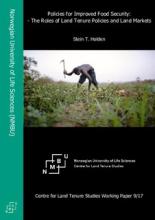Land Library
Welcome to the Land Portal Library. Explore our vast collection of open-access resources (over 74,000) including reports, journal articles, research papers, peer-reviewed publications, legal documents, videos and much more.
/ library resources
Showing items 1 through 9 of 17.This study investigates whether and to what extent rainfall shocks recurring in Sub-Saharan Africa, that have been associated with distress land rentals, enhance short-term and medium-term access to rented land by tenant households.
We assess the extent of access and degree of participation by smallholder tenants in the land rental market in Malawi. Our study is based on three rounds of nationally representative Living Standards Measurement Surveys collected in 2010, 2013 and 2016, from which we construct a balanced panel.
This chapter is written for the European Commission for a book to be published by Springer on The Role of Smallholder Farms in Food and Nutrition Security. The author takes full responsibility for the content.
The paper utilizes household panel data to investigate whether the land rental market can facilitate improved access to land for land-poor tenant households over time and thereby facilitate expansion of their farming activity.
Land use—with a special focus on agriculture—is increasingly influenced by globalization and external driving forces, causing farmers to seek opportunities to develop efficient, large-scale production systems.[...]
The Languedoc-Roussillon region of southern France is well known today for producing full-bodied red wines. Yet wine grapes are not native to France. Additionally, wine was not developed indigenously first. In the 7th century B.C.
We developed an agent-based model (ABM) to simulate farmers’ decisions on crop type and fertilizer application in response to commodity and biofuel crop prices.
Rural livelihoods and the land systems on which they depend are increasingly influenced by distant markets through economic globalization. Place-based analyses of land and livelihood system sustainability must then consider both proximate and distant influences on local decision-making.
Synergies among land institutions and institutional changes impact on land markets and in guaranteeing agro-based employment, capital injection, local economic development and infrastructural improvement.





